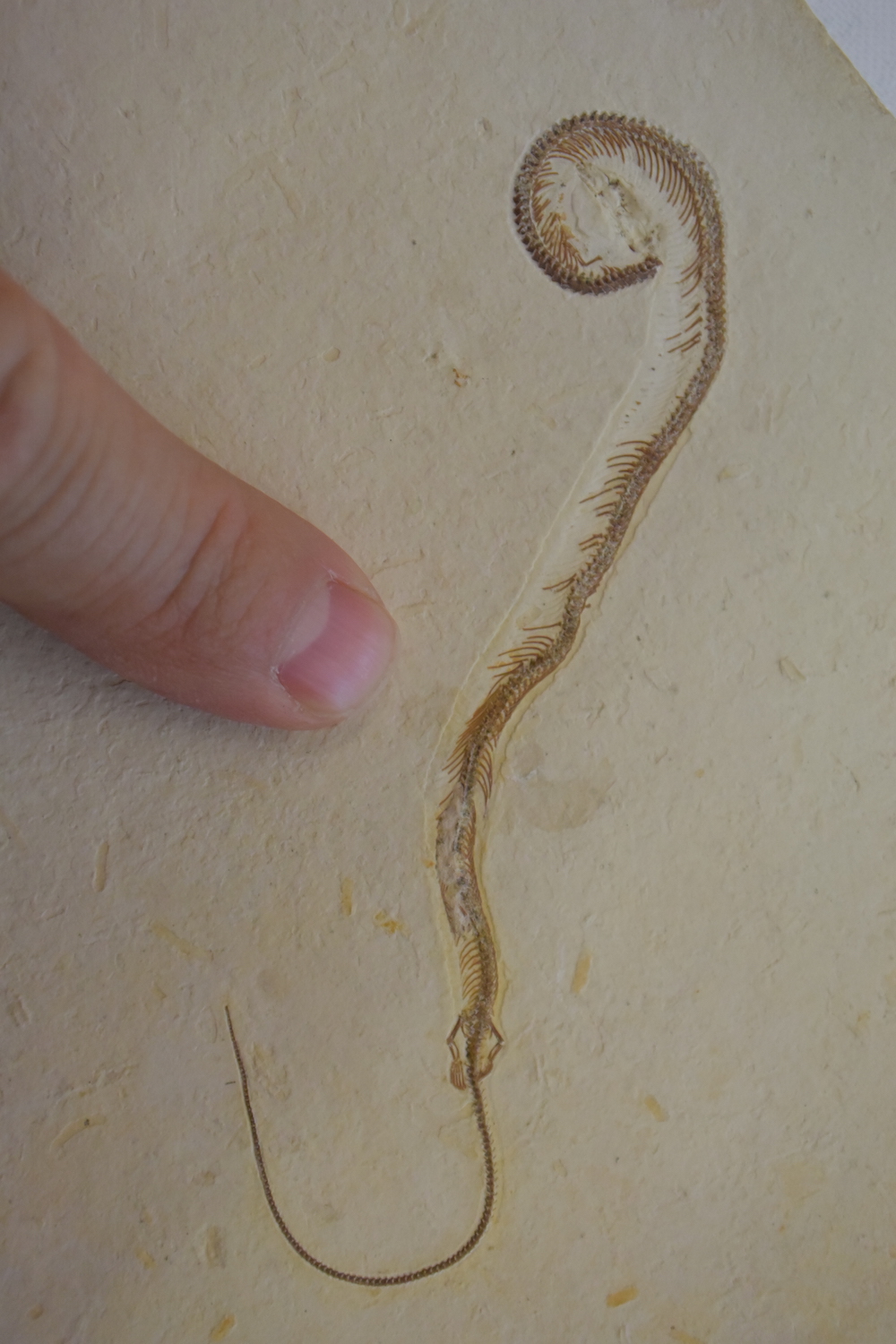Mistaken Identity? Debate Over Ancient 4-Legged Snake Heats Up

SALT LAKE CITY — A critter heralded as the first four-legged fossil snake on record may actually not be a snake, according to new research. Instead, the 120-million-year-old creature is likely a dolichosaurid, an extinct four-legged marine lizard with an elongated, snake-like body, a new analysis of the specimen finds.
"Tetrapodophis doesn't show any of those features that you would expect to see in a snake," said Michael Caldwell, a professor and chair of biological sciences at the University of Alberta in Edmonton, Canada, who is leading the new investigation into the enigmatic fossil.
For instance, Tetrapodophis amplectus doesn't have hooked teeth like a snake does, nor does it have a snake-like skull and skeleton, Caldwell said. Other anatomical details that have been found in ancient and modern snakes are also missing, including the subdental ridge in the mouth and zygosphenes, which are special joints that are found between snake vertebrae, he said. [See Photos of the Four-Legged, Snakelike Creature]
Rather, the creature is likely a dolichosaurid, which falls under the squamate (scaly reptile) umbrella, he said. It's unclear exactly how dolichosaurids are related to snakes, but some evidence suggests they are a sister group to the slithery reptiles, Caldwell said.
He even pointed to the bones of prey that were preserved in the specimen's gut — the animal's last meal before it died. These are likely fish bones — a theory that fits the dolichosaurid interpretation, because dolichosaurids lived in the water, Caldwell said.
Brazilian fossil
T. amplectus made a big splash last year when a study published in the journal Science in July 2015 announced that the fossil was the so-called missing link, which showed that snakes evolved from four-legged lizards. The researchers reported that the 7.8-inch-long (20 centimeters) specimen probably descended from terrestrial burrowers (rather than marine animals), and that it likely used its tiny limbs for grasping prey for hunting and holding mates while reproducing.
David Martill, a co-researcher of the 2015 study and a professor of paleobiology at the University of Portsmouth in England, came across the fossil while he was on a field trip with his students at the Solnhofen Museum (formerly known as the Bürgermeister-Müller-Museum) in Germany.
Get the world’s most fascinating discoveries delivered straight to your inbox.
The exhibit featured fossils from the Crato Formation in northeastern Brazil, and one specimen, titled "Unknown fossil," caught Martill's eye. It looked like a snake, but it had four exquisitely small limbs — a feature that had never before been seen in a snake. Martill asked the museum if he could study it, and eventually he and his colleagues named it Tetrapodophis amplectus (which means, literally, four-legged snake).
Brewing controversy
Within two months of the 2015 study's publication, Caldwell and his colleague Robert Reisz, a paleontologist at the University of Toronto, traveled to Germany to see the specimen for themselves. [7 Shocking Snake Stories]
They brought two microscopes with them — a digital and a dissecting microscope — so that they could take photos of the small critter at 200 times the magnification of the naked eye, Caldwell said.
The specimen comprises a part and counterpart — which are basically the sides of the two rocks that held the creature. When the rock was split in two, the "part" retained some pieces of the skull and most of the creature's body, and the "counterpart" retained the other part of the skull. When they were studied together, there were myriad clues that the animal was not a snake, Caldwell said.
However, Caldwell and Reisz may be the last scientists to examine the specimen in person. The fossil is privately owned, and it has since been removed from the museum, meaning other paleontologists can't study it, Caldwell said.
Moreover, the specimen doesn't have a reported provenance, so it's unknown when and where it was found, as well as who sold and bought it, he said. In Brazil, it has been illegal since 1942 to remove holotype fossils (holotypes are the first described specimen of a newfound species) from the country, and there's also a ban on removing paratypes (subsequently found specimens of a known species) without a permit. It's unclear whether T. amplectus was discovered before or after that law went into effect, Caldwell and his colleagues said. However, if it was discovered after 1942, it was likely smuggled out of the country, Caldwell said.
Tiago Simões, a doctoral candidate of vertebrate paleontology at the University of Alberta, who is working with Caldwell, noted that the fossil is from a region containing limestone that was quarried in the 1960s and 1970s for commercial purposes. Some fossils were found before then, but the vast majority were discovered after the 1942 ruling, said Simões, who is from Brazil.
"It's highly likely that the material was collected after the 1960s and 1970s," Simões told Live Science. [6 Strange Species Discovered in Museums]
Given its mysterious past and current out-of-reach status, it might be best to "strike Tetrapodophis from the record of snake evolution until more specimens can be found or that specimen comes back [from the private collector] and can be put in the public trust," said Jason Head, a lecturer in zoology and curator of vertebrate paleontology at the University Museum of Zoology at the University of Cambridge in England, who was not involved with either the 2015 study or the new research.
"[In] the original description, the analysis was not very convincing to begin with," Head said. "It was a very problematic study. Certainly the work that Dr. Caldwell presented today illustrates a lot of the ambiguities of the animal."
But, whether the specimen is a snake remains a mystery.
"We're never going to know whether or not the original analysis was right or wrong, or whether or not Dr. Caldwell's work was right or wrong, because we can't replicate either observation," Head said.
Supersnake
The authors of the original study are defending their work, and said that it's clear that T. amplectus is a four-legged snake.
"I don't think Caldwell has made a case for Tetrapodophis not being a snake," Martill told Live Science in an email. "Some of his observations, such as saying that the teeth are not recumbent [pointing backward], are plain wrong."
He added that, "Tetrapodophis has a single row of belly scales; Tetrapodophis has snake vertebral articulations (although a couple of lizard groups do have these). There are many more snake features, too, based on skull anatomy."
Martill's colleague and co-author Nicholas Longrich, a senior lecturer in evolutionary biology at the University of Bath, in England, said, "I would happily bet a million dollars it’s a snake." Longrich contested the assessment that the specimen didn't have a subdental ridge or visible zygosphenes, as well as myriad other features that Caldwell and his colleagues listed as missing. Moreover, the prey in the animal's gut likely aren't fish bones, unless it's a Tiktaalik (a fish with limbs), "because the bones in the gut include leg bones," Longrich said.
"I’m as confident of Tetrapodophis being a snake as I have ever been of anything in my scientific career," Longrich wrote in an email to Live Science.
Questions about snake limbs remain a popular subject among scientists. Two studies published last week found that snakes likely sported limbs up until about 150 million years ago, when genetic mutations caused them to lose the ability to develop arms and legs. But, if T. amplectus loses its snake status, there will be zero fossil evidence that snakes once had four limbs, "which is a real bummer," Caldwell said.
The research, which has yet to be published in a peer-reviewed journal, was presented Wednesday (Oct. 26) at the 2016 Society of Vertebrate Paleontology meeting.
Original article on Live Science.

Laura is the managing editor at Live Science. She also runs the archaeology section and the Life's Little Mysteries series. Her work has appeared in The New York Times, Scholastic, Popular Science and Spectrum, a site on autism research. She has won multiple awards from the Society of Professional Journalists and the Washington Newspaper Publishers Association for her reporting at a weekly newspaper near Seattle. Laura holds a bachelor's degree in English literature and psychology from Washington University in St. Louis and a master's degree in science writing from NYU.





